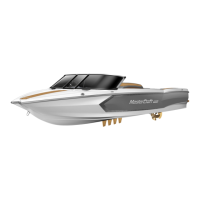2017 OWNERS MANUAL / 42
MEETING
If you are meeting another vessel head-on, and you are close
enough to run the risk of collision, neither of you has the right-
of-way. Both of you should alter course to avoid an accident. You
should keep the other vessel on your port (left) side. (This rule
doesn’t apply if both of you can clear each other by continuing your
set course and speed.)
CROSSING
When two (2) power-driven vessels are crossing each other’s path
close enough to run the risk of collision, the vessel that views the
crossing vessel to the starboard (right) side must give way.
If the other vessel is to the port (left) side, you are the stand-on
vessel, and provided the other vessel gives you the right-of-way,
maintain your course and direction.
OVERTAKING
If you are passing another vessel, you are the give-way vessel. This
means that the other vessel is expected to maintain its course and
speed. You must stay out of its way as you clear it, altering course
and speed as necessary.
Conversely, if you are being passed by another vessel, you are the
stand-on vessel, and you should maintain your speed and direction
so that the vessel can be steered around you.
)
2 short blasts
(1 sec. each)
2 short blasts
(1 sec. each)
1 short blast
(1 sec. each)
Stand-On Vessel
Overtaken
Five-Way Vessel
1 short blast
(1 sec.)
G
2 short blasts (1 sec. each)
1 short blast (1 sec.)
Overtaking
(keep clear)
1 short blast (1 sec.

